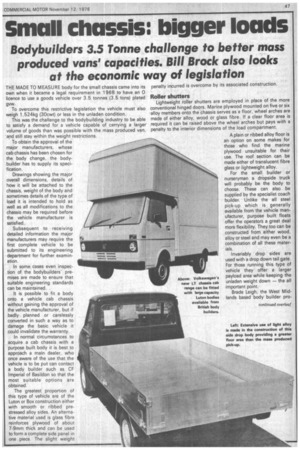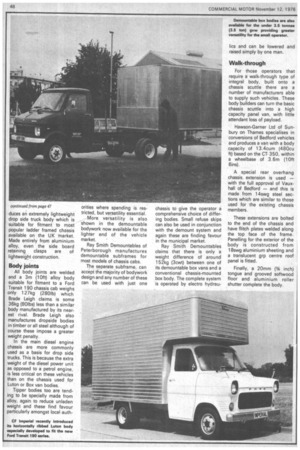Small chassis: bigger loads
Page 49

Page 50

If you've noticed an error in this article please click here to report it so we can fix it.
Bodybuilders 3.5 Tonne challenge to better mass produced vans' capacities. Bill Brock also looks at the economic way of legislation
THE MADE TO MEASURE body for the small chassis came into its own when it became a legal requirement in 1968 to have an 0 licence to use a goods vehicle over 3,5 tonnes (3.5 tons) plated gvw.
To overcome this restrictive legislation the vehicle must also weigh 1,524kg (30cwt) or less in the unladen condition.
This was the challenge to the bodybuilding industry to be able to satisfy a demand for a vehicle capable of carrying a larger volume of goods than was possible with the mass produced van, and still stay within the weight restrictions.
To obtain the approval of the major manufacturers, whose cab chassis has been chosen for the body change, the bodybuilder has to supply its specification.
Drawings showing the major overall dimensions, details of how it will be attached to the chassis, weight of the body and sometimes details of the type of load it is intended to hold as well as all modifications to the chassis may be required before the vehicle manufacturer is satisfied.
Subsequent to receiving detailed information the major manufacturers may require the first complete vehicle to be submitted to its engineering department for further examination.
In some cases even inspection of the bodybuilders' premises are made to ensure that suitable engineering standards can be maintained.
It is possible to fit a body onto a vehicle cab chassis without gaining the approval of the vehicle manufacturer, but if badly planned or carelessly converted in such a way as to damage the basic vehicle it could invalidate the warranty.
In normal circumstances to acquire a cab chassis with a purpose built body it is best to approach a main dealer, who once aware of the use that the vehicle is to be put can contact a body builder such as CF Imperial of Basildon so that the most suitable options are obtained.
The greatest proportion of this type of vehicle are of the Luton or Box construction either with smooth or ribbed prestressed alloy sides. An alternative material used is glass fibre reinforces plywood of about 7-9mm thick and can be used to form a complete side panel in one piece. The slight weight penalty incurred is overcome by its associated construction.
Roller shutters
Lightweight roller shutters are employed in place of the more conventional hinged doors. Marine plywood mounted on five or six alloy members onto the chassis serves as a floor, wheel arches are made of either alloy, wood or glass fibre. If a clear floor area is required it can be raised above the wheel arches but pays with a penalty to the interior dimensions of the load compartment.
A plain or ribbed alloy floor is an option on some makes for those who find the marine plywood unsuitable for their use. The roof section can be made either of translucent fibre glass or lightweight alloy.
For the small. builder or nurseryman a dropside truck will probably be the body to choose. These can also be supplied by the specialist coach builder. Unlike the all steel pick-up which is generally available from the vehicle manufacturer, purpose built floats offer the operators a great deal More flexibility. They too can be constructed from either wood, alloy or steel and may even be a combination of all these materials.
Invariably drop sides are used with a drop down tail gate. For those running this type of vehicle they offer a larger payload area while keeping the unladen weight down — the all important point.
Brade Leigh, the West Midlands based body builder pro duces an extremely lightweight drop side truck body which is suitable for fitment to most popular ladder framed chassis available on the UK market. Made entirely from aluminium alloy, even the side board retaining clasps are of lightweight construction.
Body joints
All body joints are welded and a 3m (10ft) alloy body suitable for fitment to a Ford Transit 190 chassis cab weighs only 1 27kg (2801b) which Brade Leigh claims is some 36kg (801bs) less than a similar body manufactured by its nearest rival. Brade Leigh also manufactures dropside bodies in timber or all steel although of course these impose a greater weight penalty.
In the main diesel engine chassis are more commonly used as a basis for drop side trucks. This is because the extra weight of the diesel power unit as opposed to a petrol engine, is less critical on these vehicles than on the chassis used for Luton or Box van bodies.
Tipper bodies too are tending to be specially made from alloy, again to reduce unladen weight and these find favour particularly amongst local auth orities where spending is restricted, but versatility essential.
More versatility is also shown in the demountable bodywork now available for the lighter end of the vehicle market.
Ray Smith Demountables of Peterborough manufactures demountable subframes for most models of chassis cabs.
The separate subframe, can accept the majority of bodywork design and any number of these can be used with just one chassis to give the operator a comprehensive choice of differing bodies. Small refuse skips can also be used in conjunction with the demount system and again these are finding favour in the municipal market.
Ray Smith Demountables claims that there is only a weight difference of around 1 52kg (3cwt) between one of its demountable box vans and a conventional chassis-mounted box body. The complete system is operated by electro hydrau lics and can be lowered and raised simply by one man.
Walk-through
For those operators that require a walk-through type of integral body, built onto a chassis scuttle there are a number of manufacturers able to supply such vehicles. These body builders can turn the basic chassis scuttle into a high capacity panel van, with little attendant loss of payload.
Hawson-Garner Ltd of Sunbury on Thames specialises in conversions of Bedford vehicles and produces a van with a body capacity of 1 3.4cum (480cu ft) based on the CT. 350, within a wheelbase of 3.6m (10ft 6ins).
A special rear overhang chassis extension is used — with the full approval of Vauxhall of Bedford — and this is made from 1 4swg steel sections which are similar to those used for the existing chassis members.
These extensions are bolted to the end of the chassis and have flitch plates welded along the top face of the frame. Panelling for the exterior of the body is constructed from 18swg aluminium sheeting and a translucent grp centre roof panel is fitted.
Finally, a 20mm (34 inch) tongue and grooved softwood floor and aluminium roller shutter complete the body.












































































































































